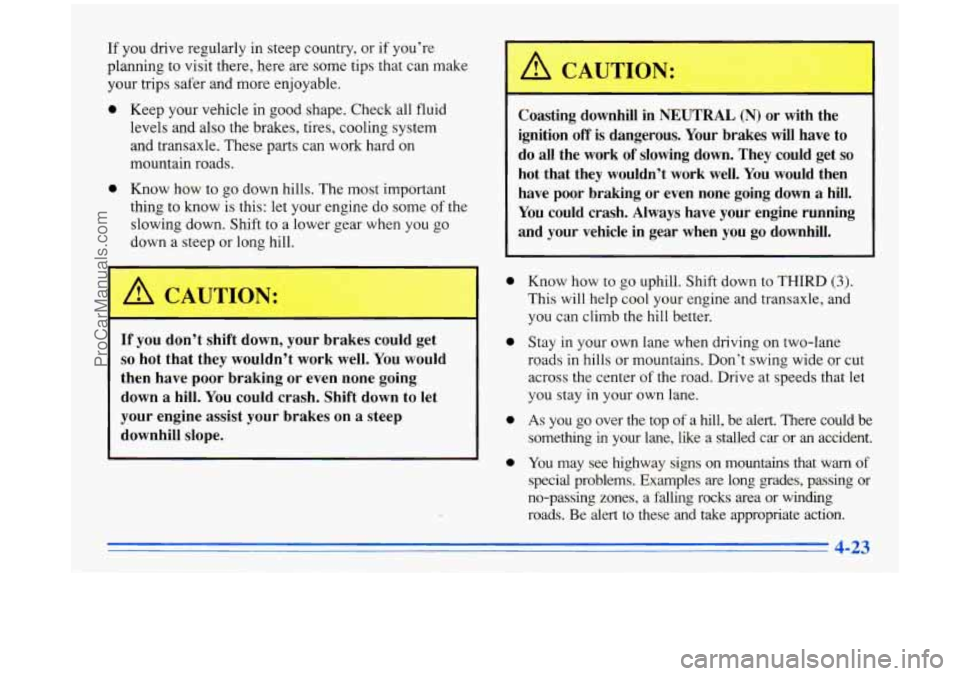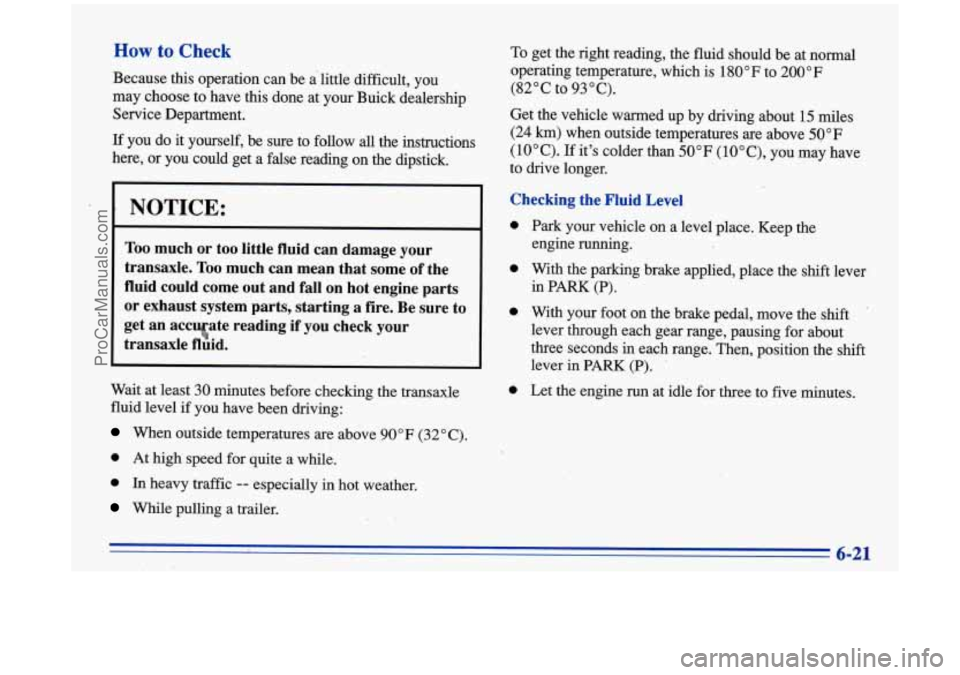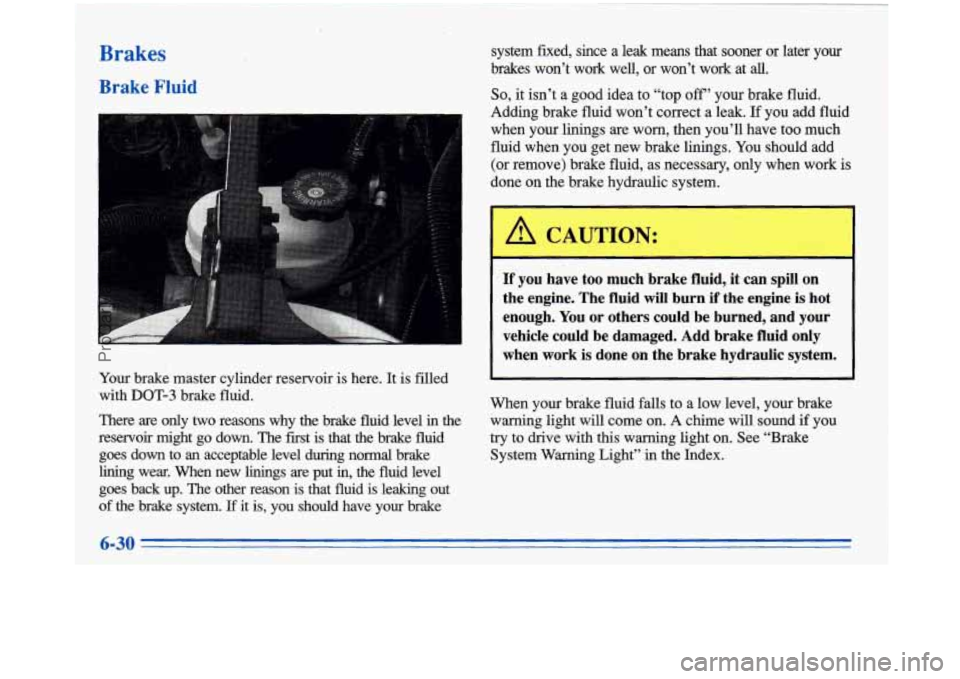Page 197 of 388

If you drive regularly in steep country, or if you’re
planning to visit there, here are some tips that can make
your trips safer and more enjoyable.
0 Keep your vehicle in good shape. Check all fluid
levels and
also the brakes, tires, cooling system
and transaxle. These parts can work hard on
mountain roads.
0 Know how to go down hills. The most important
thing to know is this: let your engine do some
of the
slowing down. Shift
to a lower gear when you go
down a steep or long hill.
A CAUTION:
If you don’t shift down, your brakes could get
so hot that they wouldn’t work well. You would
then have poor braking or even none going
down
a hill. You could crash. Shift down to let
your engine assist your brakes on
a steep
downhill slope. Coasting
downhill in
NEUTRAL (N) or with the
ignition
off is dangerous. Your brakes will have to
do all the work
of slowing down. They could get so
hot that they wouldn’t work well. You would then
have poor braking or even none going down a hill.
You could crash. Always have your engine running
and your vehicle in gear when you go downhill.
0
0
0
0
Know how to go uphill. Shift down to THIRD (3).
This will help cool your engine and transaxle, and
you can climb the hill better.
Stay in your own lane when driving on two-lane
roads in hills or mountains. Don’t swing wide or cut
across the center
of the road. Drive at speeds that let
you stay in your own lane.
As you go over the top of a hill, be alert. There could be
something in your lane, like a stalled car or an accident.
You may see highway
signs on mountains that warn of
special problems. Examples are long grades, passing or
no-passing zones, a falling rocks area or winding
roads. Be alert
to these and take appropriate action.
4-23
ProCarManuals.com
Page 211 of 388
When You Are Ready to Leave After
Parking on a Hill
1. Apply your regular brakes and hold the pedal down
while you:
Start your engine;
Shift into a gear; and
e Release the parking brake.
2. Let up on the brake pedal.
3. Drive slowly until the trailer is clear of the chocks.
4. Stop and have someone pick up and store the chocks.
Maintenance When Trailer Towing
Your vehicle will need service more often when you’re
pulling a trailer. See the Maintenance Schedule for more
on this. Things that are especially important in trailer
operation are automatic transaxle fluid (don’t overfill),
engine oil, belts, cooling system and brake adjustment.
Each
of these is covered in this manual, and the Index
will help
you find them quickly. If you’re trailering, it’s
a good idea to review these sections before you start
your trip.
Check periodically to see that all hitch nuts and bolts
are tight.
ProCarManuals.com
Page 256 of 388
NOTICE:
If you need a new cap, be sure to get the right
type. Your dealer can get one for
you. If you get
the wrong type, it may not fit or have proper
venting, and your fuel tank and emissions system
might be damaged.
Checking Things Under the Hood
I
I
An electric fan under the hood can start up and
injure you even when the engine is not running.
Keep hands, clothing and tools away from
any
underhood electric fan.
I
Things that burn can get on hot engine parts and
start
a fire. These include liquids like gasoline,
oil, coolant, brake fluid, windshield washer and
other fluids, and plastic or rubber.
You or others
could be burned. Be careful not to drop or spill
things that will burn onto
a hot engine.
Hood Release
ProCarManuals.com
Page 258 of 388
wv DCIIC~ II [~uut: n) u~gmc (L36)
When you open the hood on the 3800 (L36) engine, here’s what you will see:
A. Engine Coolant Surge Tank
B. Battery
C. Radiator Pressure Cap
D. Engine Oil Dipstick E.
Oil
Fill Cap
E Automatic Transaxle Fluid
Dipstick
G. Brake Master Cylinder
.. ,.
H. Air Cleaner
I. Windshield Washer Fluid
Reservoir
ProCarManuals.com
Page 259 of 388
3800 Supercharged (L67) Engine (Option)
When you open the hood on the 3800 Supercharged engine, here's what you will see:
... . .
A. Supercharged Engine Coolant
B. Battery
C. Radiator Pressure Cap
Surge
Tank D. Supercharged
Engine Oil
E. Supercharged Oil Fill Cap
F. Automatic Transaxle Fluid
Dipstick
Dipstick
-.
G. Brake
Master Cylinder
H. Air Cleaner
I. Windshield Washer Fluid
Reservoir
6-11
ProCarManuals.com
Page 269 of 388

How to Check
Because this operation can be a little difficult, you
may choose to have
this done at your hick dealership
Service' Department.
If you do it yourself, be sure to follow all the instructions
here, or you could get a false reading on the dipstick.
1 NOTICE:
Too much or too little fluid can damage your
transaxle.
Too much can mean that some of the
fluid could come out and fall on hot engine parts
or exhaust system parts, starting a fire. Be sure to
get an acc ate reading if
you check your
transaxle fluid. UT
Wait at least 30 minutes before checking the transaxle
fluid level
if you have been driving:
When outside temperatures are above 90°F (32°C).
0 At high speed for quite a while.
0 In heavy traffic -- especially in hot weather.
While pulling a trailer. To
get the right reading, the fluid should be at normal
operating temperature, which is
180 "F to 200 "F
(82°C to 93°C).
Get the vehicle warmed up by driving about
15 miles
(24
km) when outside temperatures are above 50°F
(1.0"C). If it's colder than 50°F (lO"C), you may have
to drive longer.
Checking the Fluid Level
0
0
0
0
Park your vehicle on a level place.. Keep the
engine running.
With the parking brake applied, place the
shift lever
in PARK (P).
With your foot on the brake pedal, move the shift '
lever through each gear range, pausing for about
three seconds in each range. Then, position the shift
lever
in PARK (P). '
Let the engine run at idle for three to five rhinutes.
6-21
ProCarManuals.com
Page 270 of 388
I
Then, without shutting off the engine, follow these steps:
1. The transaxle fluid
dipstick top is
a
round loop and is
next to the brake
master cylinder
behind the engine
block. Pull out the
dipstick and wipe it
I with a clean rag or
paper towel.
3. Check both sides of the dipstick, and read the lower
level. The fluid level must
be in the cross-hatched area.
2. Push it back in all the way, wait three seconds and
then pull it back out again.
4. If the fluid level is in the acceptable range, push the
dipstick back in all the way.
8
6-22
I
ProCarManuals.com
Page 278 of 388

Brakes
Brake Fluid
system fixed, since a leak means that sooner or later your
brakes won’t work well, or won’t work at
all.
So, it isn’t a good idea to “top off’ your brake fluid.
Adding brake fluid won’t correct a
leak. If you add fluid
when your linings are worn, then you’ll have too much
fluid when you get new brake linings. You should add
(or remove) brake fluid, as necessary, only when work is
done on the brake hydraulic system.
There are only
two reasons why the brake fluid level in the
reservoir might go down. ,The first is that the brake fluid
goes down to
an acceptable level during normal brake
1 lining wear. When new linings are put in, the fluid level
I goes back up. The other reason is that fluid is leaking out
of the brake system.
If it is, you should have your brake !
If you have too much brake fluid, it can spill on
the engine. The fluid will burn if the engine is hot
enough. You or others could be burned, and your
vehicle could be damaged. Add brake fluid only
when work is done on the brake hydraulic system.
When your brake fluid falls to a low level, your brake
warning light will come
on. A chime will sound if you
try to drive with this warning light on. See “Brake
System
Warning Light” in the Index.
ProCarManuals.com